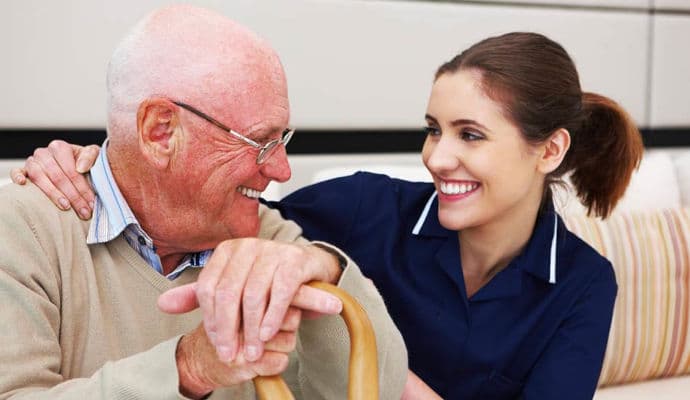The decision to invite a professional caregiver into your home to care for your loved one is a profound step, often tangled with a complex mix of relief and trepidation. While you know you need the support, it’s common to be held back by a quiet undercurrent of worry: “Will they be kind? Can I truly trust them? Will my parent be safe?”
These concerns are not just valid; they are a testament to your deep love and dedication. The goal isn’t to eliminate every worry, but to build a framework of trust and oversight that finally lets you exhale.

Let’s explore three essential strategies that provide the clarity and confidence you need to welcome support with greater peace of mind.
Coming to Terms with Hiring a Caregiver
If you’re concerned or feeling guilty about hiring someone to help care for your older adult, you’re not alone.
Even if you wish you could be there for them 24/7, it’s not realistic. To keep going as a long-term caregiver, you need regular breaks and time for yourself.
That’s why getting help with caregiving is so essential.
But when you’ve hired an in home caregiver to help you care for your older adult, you might still worry about what happens when you’re not around.
Previously, we covered simple ways to keep an eye on your hired caregiver.
When you know that an older adult’s needs are being met and they’re treated kindly, it puts your mind at ease. That allows you to relax and enjoy your well-deserved time away from caregiving.
Here are three tips to help you feel even more confident that your older adult is getting good care. They’ll also help you spot red flags so you can proactively prevent serious problems.
3 tips for Finding the Right In-Home Caregiver
1. Keep background checks up to date
Even if the initial background check on your in-home caregiver didn’t show any problems, it’s a good idea to repeat the process every 6 to 12 months.
This keeps you aware of any changes or updates.
Check their name against national databases, local court records, and state elder abuse registries (if available).
Verify their Social Security number to see if they’ve used any other names. If they drive your older adult around, check their driving record too.
If you hired through a home care agency, find out how often the agency refreshes background checks and which databases they check against to make sure their checks are comprehensive.
2. Be alert for signs of trouble
If the caregiver isn’t doing a good job, there will probably be some warning signs.
If you notice anything that makes you feel uneasy, trust your gut. Check into the situation to learn more and track repeat occurrences.
Sure, accidents do happen from time to time, but frequent accidents point to a problem.
Some examples of red flags:
- The caregiver ignores your instructions and does things when and how they choose.
- You can’t reach the caregiver when they’re with your older adult.
- The caregiver is obviously focused on their phone, TV, or computer.
- Your older adult’s personal hygiene is being neglected.
- Your older adult shows unexplained signs of physical or mental trauma, like bruising, sudden change of behavior (fear, agitation), etc.
- The caregiver doesn’t seem to care about household safety.
- You see multiple negative reviews of the caregiver on reputable websites.
3. Use video cameras for monitoring
Monitoring with video cameras is often used to discourage abuse. The point isn’t to catch someone in the act, but to prevent it from happening in the first place.
If you plan to use cameras to monitor a hired caregiver, be upfront about it when you hire them.
Honest caregivers usually won’t mind being recorded if they’re aware that it’s happening. Plus, this also protects them from false accusations.
But someone could be justifiably angry if they found out later that you’ve been secretly recording them.
Final Thoughts on Finding the Right In-Home Caregiver
Implementing these steps transforms you from an anxious observer into a confident manager of care. This peace of mind is not a luxury; it’s the foundation that allows you to share the caregiving load without sacrificing your loved one’s safety or your own well-being. Remember, bringing in help is not a replacement for your love and vigilance—it’s an extension of it.
By setting clear expectations and establishing communication systems, you are building a team. Permit yourself to trust the process you’ve created, and embrace the gift of time and mental space that a reliable caregiver can provide. You’ve earned it.
Recommended for you:
- 6 Ways to Make It Easier for Caregivers to Take a Break
- When They Say No: 8 Ways to Introduce In-Home Care for Seniors
- Affordable In Home Care: 8 Ways to Lower Senior Care Costs
By DailyCaring Editorial Team
Image: Colony Care at Home
About the Author

Connie is the founder of DailyCaring.com and was a hands-on caregiver for her grandmother for 20 years. (Grandma made it to 101 years old!) She knows how challenging, overwhelming, and all-consuming caring for an older adult can be. She also understands the importance of support, especially in the form of practical solutions, valuable resources, and self-care tips.












